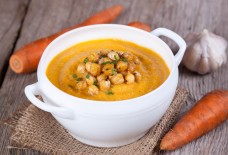Efforts in Gluten-Free Alternatives are Now Recognized
The Kitchen GirlBy: Joyce Behrens, Contributing Writer
Gluten-free options are quickly becoming essential staples in restaurants and food markets. The reason for the awareness of this gluten is dietary restrictions such as Celiac disease, which is an immune disorder that reacts to gluten products. Examples that contain gluten are wheat, rye, and barley. In the Arab world, following a gluten-free diet is difficult since common foods, such as pita bread, are made with flour. In modern society, the Arab world is looking for possible ways to allow gluten-free alternatives in their cuisine. However, there are some gluten-free food options that exist already. Also, there have been modifications to recipes. When it comes to eating out, there is a creative way to know if specific dishes are identified as safe. This is how the Arab world takes on the challenge of a gluten-free diet.
Types of Gluten-Free Food
Gluten-free foods already exist in the Arab world, you probably just didn’t realize it! Mezze platters, a variety of small appetizers, have some dips and sides that are safe to eat. Hummus is made from chickpeas and tahini, these can be eaten with vegetables primarily. Warak Enab (as known as stuffed grape leaves) are made with seasoned rice and beef. Sometimes, lemon juice will be drizzled on top. Gluten-free meals exist! For example, Tagine, which is a meat and vegetable stew, contains no gluten in the stew itself. It’s safe to eat, as long as there is no bread on the side. Street food in the Arab world can also be gluten-free. Kalinti is an example. The texture is like flan but made with chickpea flour and eggs.
Foods to Avoid
Some common foods that are popular in the Arab world are not gluten-free. Pita bread is an example since it’s a wheat-based bread. It’s the main component for certain dishes, such as mezze platters and shawarma sandwiches. Another type of gluten food to avoid is couscous. Couscous is a common starch from the North African region, and especially popular in Algeria. Since couscous is like rice, most people tend to forget that it’s made with wheat semolina and barley. There is gluten in desserts and small treats as well. Ma’amoul, which is a shortbread cookie stuffed with dates or nuts. The outer part of the ma’amoul is made with flour. Experts recommend not eat these foods if you have a gluten allergy. However, modern society has put an effort to make changes for gluten-free diets.
Substitutions
The Spruce EatsToday, gluten-free alternatives are becoming more widespread. Chefs in the Arab world have been looking for ways to replace gluten-containing ingredients. For example, kibbeh, which are small fritters of ground meat (beef or lamb), is coated in bulgar wheat. You can replace the bulgar wheat with quinoa. Quinoa is a grain with the same texture as bulgar, without gluten. This goes for tabbouleh as well, which is parsley, tomato, and bulgar salad.
There are several alternatives to pita bread. Some markets in the Arab world offer gluten-free pita bread. This alternation is made with gluten-free flour, which can be made out of rice or many other alternatives. There are different adjustments when comes to using crispy pita bread for dishes. Fattoush salads and lentil soup use crisped up pita bread as a crunchy component. The best recommendation is to scratch the pita entirely. Instead, it’s best to use rice crackers as the texture inside meals.
Gluten-free Cards
When dining out at restaurants, it’s difficult to know what options are safe to eat. Not everything on the menu will be identified as gluten-free. There is, however, a way to what foods are safe for dietary restrictions when you go out. Some Arab countries, such as Morocco and Egypt, have created gluten-free cards. These cards will allow knowing if certain foods on the menu are approved gluten-free. It’s basically a go-to index sheet to see if specific foods and dishes identify as gluten-free.
Check out our Blog here!



